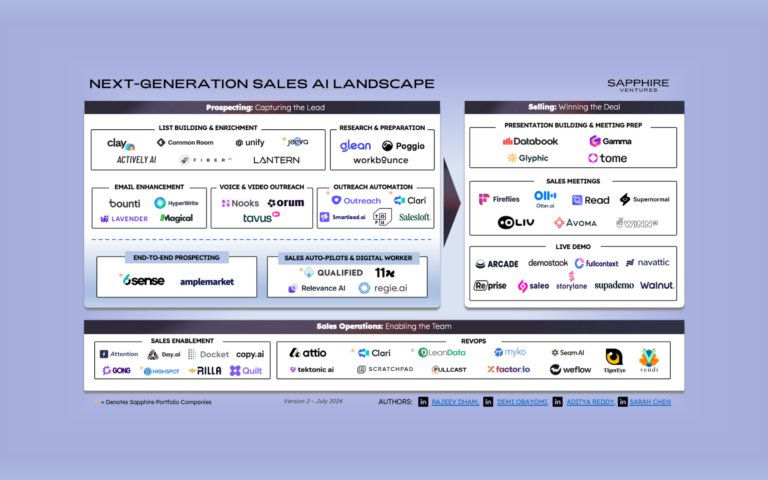Before Netscape released its browser in 1994, most people didn’t use the internet. Though the technology had been around for more than a decade, it was largely the purview of scientists and engineers until Netscape made it accessible to all. Today, I believe we’re at a similar inflection point with generative AI. Transformer and large language models — the technology underlying generative AI tools — have existed for years, but the launch of OpenAI’s ChatGPT last fall placed it at the fingertips of nearly everyone with access to the Internet. Now, anyone can enter a prompt in conversational terms and produce what appears to be meaningful content instantaneously.
Understandably, generative AI has captured the public imagination, spawning predictions of both earth-shattering transformation and apocalyptic doom. Whenever a new technology invites so much buzz, it’s exciting, but it’s also worth taking the long view. The tools attracting so much attention today have been built on several decades of innovation, and at least five distinct eras of AI. The way I see it, generative AI presents us with an incredible opportunity and its vast possibilities will be here before we know it, but I believe it’s also in the newest wave of AI innovation where we are very much still in the first inning.
As I look at dozens of generative AI companies per week, my thoughts are only further cemented. With any transformational technology, we should take an optimistic, but measured approach, by fueling innovation through capital and resources, while at the same time understanding that tangible results take time. At Sapphire, we are embracing this strategy by announcing that we’re deepening our commitment to AI by investing more than $1 billion in AI-powered enterprise technology startups.
Now let’s take a look at the five eras of AI and the companies that got us to where we are today. But first, a brief history:
A brief history of AI
Innovations that seem to come out of nowhere almost always have deeper roots. As an investor who has been backing enterprise tech startups for nearly three decades, I’ve observed that we’re now living through the fifth distinct cycle of AI. Each past era was the subject of similar hype that was ultimately tempered by the availability of data, computing power, storage capacity and other factors. I don’t necessarily believe these five phases had a distinct beginning and end–they informed future eras and often continued to develop alongside subsequent stages.
The 5 eras of AI
Era 1: AI 1.0
Dating back to the early 1990s, the first AI movement was based on heuristic rules and statistical models. A programming language called LISP was used to program applications based on an algorithm known as a decision tree.
- Symbolics: Symbolics was a computer company that specialized in LISP machines, which were computers designed specifically for AI applications and was one of the leading AI companies in the early 1990s.
- Cycorp: Founded in 1994, Cycorp aimed to develop a comprehensive common-sense knowledge base, known as Cyc, which could be used to power AI systems.
- Nuance Communications: Established in 1992, Nuance Communications focused on speech recognition and natural language processing technologies, which are essential components of AI systems. Nuance was recently acquired by Microsoft.
- SRI International: While not solely an AI company, SRI International played a crucial role in AI research during the 1990s. It developed technologies like the CALO project, which later contributed to the creation of Siri.
Models were limited in terms of the number of inputs they could handle and outputs they could predict; they lacked the capacity to model human behavior or natural phenomena. Hardware firms such as Thinking Machines attracted investment to create supercomputers, machines capable of parallel processing. One of the most useful applications of this era of AI was in quant funds, which used algorithms to inform stock trades. Ultimately, this phase of AI was stymied by limitations in computing power.
Era 2: Neural Networks
The mid-1990s and early-2000s saw the rise of neural networks, computing systems that tried to mimic the way human and animal brains operate. Neural networks mostly stayed in academia, again hampered by limitations in computing power. This work served as the precursor for transformer models, the kind of deep learning model behind generative AI.
In the year 2010, deep learning started to gain attention and began to establish itself as a powerful approach within the field of machine learning. While the number of companies focused solely on deep learning was still relatively limited compared to today, there were several notable players that were active in this area. Some of the deep learning companies in 2010 included:
- DeepMind Technologies: DeepMind, founded in 2010, quickly emerged as a leader in the field of deep learning. The company developed cutting-edge techniques and algorithms, including the famous deep reinforcement learning algorithm called Deep Q-Network (DQN). DeepMind’s breakthroughs eventually led to the development of impressive deep learning models like AlphaGo. DeepMind was acquired by Google, and eventually engineers from DeepMind went on to start a large number of current generative AI companies.
- Nervana Systems: Nervana Systems, founded in 2014 and later acquired by Intel, focused on developing specialized hardware and software solutions for deep learning. It aimed to optimize deep learning computations and accelerate training and inference processes.
- Clarifai: Clarifai, founded in 2013, specialized in image and video recognition using deep learning algorithms. The company provided an API that enabled developers to leverage deep learning models for tasks like object recognition, facial analysis and image tagging.
- Neurala: Neurala, founded in 2006, but gaining traction in the deep learning field around 2010, focused on developing software and solutions for deep learning-based visual intelligence. Neurala aimed to enable real-time recognition and analysis of visual data.
Era 3: Predictive AI
In the mid- to late-2000s, AI models emerged that could analyze trends and patterns in past data and use that insight to predict future behavior. A prime example was IBM Watson, which wowed the public by using its predictive powers to beat Ken Jennings, the reigning human “Jeopardy!” champion. The technology’s reach accelerated with the advent of cloud computing. Eventually, it was deployed to forecast everything from hurricanes to customer sales. Predictions were not always 100% accurate, but the technology did make life easier and business decisions better-informed on many fronts.
Venture capital firms played a big role in this era, investing in companies like DataRobot (a Sapphire investment), Palantir, H2O.ai and Tecton. Predictive algorithms were only as good as the data they were fed. Many of these models got smarter over time, as data sources became richer and computing resources expanded.
Era 4: AI for autonomous vehicles
Predictive AI is part of what helped bring autonomous vehicles, robots and other iterations of physical AI to the next level. Self-driving cars, trucks and food-delivery robots had to learn how to recognize and map objects and predict what would happen next in the physical world. VCs played a big role in funding firms in this sphere, such as Waymo and Zoox. While companies have made incredible progress in this space, it’s safe to say that the self-driving car revolution, for example, has not come as quickly as boosters initially predicted.
There have been several successful self-driving car startups that have made significant strides in the development and deployment of autonomous vehicle technology. Here are a few notable examples:
- Waymo (formerly the Google Self-Driving Car Project): Waymo, a subsidiary of Alphabet, is considered one of the pioneers in self-driving car technology. Waymo has been testing autonomous vehicles extensively and launched a commercial ride-hailing service in select cities.
- Cruise Automation: Acquired by General Motors in 2016, Cruise focuses on developing autonomous driving systems. The company has been conducting extensive testing and has plans to launch a commercial ride-hailing service using self-driving vehicles.
- Aurora: Founded by former executives from Google, Tesla and Uber’s self-driving divisions, Aurora develops self-driving technology for various vehicle platforms. It has partnerships with automakers and is actively working on deploying autonomous vehicles.
- Zoox: Zoox is a company that develops autonomous mobility solutions. Its focus is on designing purpose-built, electric, autonomous vehicles for urban environments. In 2020, Amazon acquired Zoox, indicating its potential in the self-driving car space.
- Argo AI: Backed by Ford and Volkswagen, Argo AI is dedicated to developing self-driving technology. It is working on creating a scalable autonomous driving system and has partnerships with automakers for integrating their technology into future vehicles.
Era 5: Generative AI
The transformer models behind generative AI were built on the deep learning work that occurred during the era of neural networks. Trained on vast volumes of data, these models can produce novel text, images, videos and other content in response to prompts. Due to the scale of capital and computing resources necessary for generative AI, incumbents are playing an outsized role in this era. Hyperscalers like Google, Amazon, Microsoft and Nvidia are aggressively investing in this technology.
Because we engage with content in so many aspects of daily life, generative AI has the potential to have a profound impact over time. One of the most transformative uses is the ability of generative AI to completely change the way we interact with software applications. Instead of using cursors and mouse clicks, Generative AI allows us to interact with software like we interact with humans in our lives. It also allows entrepreneurs with great ideas to quickly and easily build applications, greatly reducing the cost of developing software. With lower barriers to entry, apps will proliferate, and investment opportunities will increase. Founders will need less guidance from investors on product and more on GTM, distribution and gaining market share. The possibilities are vast, but generative AI is still in an experimental phase. Just like in past eras, it will take time to figure out how to effectively leverage these tools.
Learning from the past, embracing the future
Each historical era of AI brought both buzz and trepidation. Every time, the world didn’t change quite as quickly as proponents envisioned, yet some successful companies were born and technological breakthroughs helped fuel innovation down the line. And important conversations about the role of AI in society took place. Regardless of which technology is in the headlines today, the core principles of investing remain the same.
At Sapphire Ventures, we look for great companies addressing real pain points that have demonstrated product-market fit. And we look for bright, passionate, hard-working founders and CEOs that understand what it takes to build a category-defining business. We’re excited to be part of the conversation as generative AI progresses and look beyond the hype to find ways that this technology can help us work and live better.




